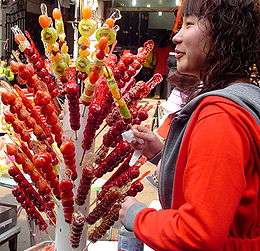Tanghulu
 Traditional bingtanghulu | |
| Alternative names | Bingtanghulu |
|---|---|
| Type | Confections |
| Place of origin | China |
| Region or state | Cities in China |
| Main ingredients | Crataegus pinnatifida, sugar syrup |
| Tanghulu | |||||||||||||||
| Traditional Chinese | 糖葫蘆 | ||||||||||||||
|---|---|---|---|---|---|---|---|---|---|---|---|---|---|---|---|
| Simplified Chinese | 糖葫芦 | ||||||||||||||
| Literal meaning | sugar bottle gourd | ||||||||||||||
| |||||||||||||||
| bīngtánghúlu | |||||||||||||||
| Traditional Chinese | 冰糖葫蘆 | ||||||||||||||
| Simplified Chinese | 冰糖葫芦 | ||||||||||||||
| Literal meaning | rock sugar bottle gourd | ||||||||||||||
| |||||||||||||||
Tanghulu (simplified Chinese: 糖葫芦; traditional Chinese: 糖葫蘆; pinyin: tánghúlu) also called bingtanghulu, is a traditional Chinese snack of candied Crataegus pinnatifida, also known as mountain hawthorn, Chinese haw, Chinese hawthorn or Chinese hawberry. It is also called shanzha(山楂), which is a chinese fruit. People mistaken tanghulu for regular candied fruits. Coated in sugary hardened syrup, tanghulu is a very popular treat in China. This sweet and sour treat for the chinese was made long ago in the ancient times where there was an emperor in rule. Today, people still eat these, mostly in northern China, and is rarely found in southern china. .[1] It originated from northern China, but it is now commonly available in most large Chinese cities, such as Beijing, Tianjin, and Shanghai.[2][3] It consists of fruits covered in hard candy on bamboo skewers that are approximately 20 cm long.
The two common names for the confection literally mean "sugar bottle gourd" and "rock sugar bottle gourd," respectively. The "sugar" or "rock sugar" refers to the sugar coating, while the "bottle gourd" refers to the slight resemblance of the snack to the shape of the gourd fruit.
Tanghulu typically has a hardened sugar coating that comes from dipping the skewer in sugar syrup, Chinese hawthorn is the traditional fruit used for the skewering,[4] but in recent times vendors have also used various other fruits, such as cherry tomatoes, mandarin oranges, strawberries, blueberries, pineapples, kiwifruit, bananas, or grapes.
Gallery
See also

- Crataegus pinnatifida
- Candy apple
- Rock candy
- Ligao Tang
- List of Chinese desserts
References
- ↑ Timothy G. Roufs Ph.D.; Kathleen Smyth Roufs (29 July 2014). Sweet Treats around the World: An Encyclopedia of Food and Culture: An Encyclopedia of Food and Culture. ABC-CLIO. p. 85. ISBN 978-1-61069-221-2.
- ↑ "Bing Tang Hulu (Candied Haw in a Stick)". Beijing 2008 Olympic Games. The Beijing Organizing Committee for the Games of the XXIX Olympiad. Archived from the original on April 29, 2009. Retrieved 1 November 2011.
- ↑ Excel Cooking (31 August 2016). Excel Chinese Cooking: Get into the Art of Chinese Cooking. Excel Cooking. p. 78. GGKEY:JK76U4GXGHZ.
- ↑ Mary Choate and Aaron Brachfeld (31 August 2015). At Home in Nature, a user's guide. Coastalfields Press. p. 315. GGKEY:K5213DDZJD2.